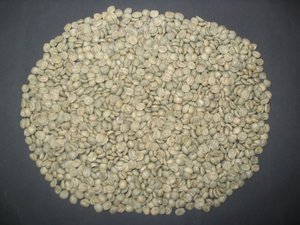
Unroasted coffee beans of the Coffea arabica variety, from Brazil
Coffee beans from two different places usually have distinctive characteristics such
as flavor (flavor criteria includes terms such as "citrus-like" or "earthy"), caffeine
content, body or mouthfeel, and acidity. These are dependent on the local environment
where the coffee plants are grown, their method of process, and the genetic subspecies
or varietal.
Some well-known arabica coffees include:
-
Colombian - Coffee was first introduced to the country of Colombia in the early
1800's. Today Maragogype, Caturra, Typica and Bourbon cultivars are grown. When
Colombian coffee is freshly roasted it has a bright acidity, is heavy in body
and is intensely aromatic. Colombia produces about 12% of the coffee in the
world, second only to Brazil.
-
Colombian Milds - Includes coffees from Colombia, Kenya, and Tanzania, all of
which are washed arabicas.
-
Costa Rican Tarrazu - from the Tarrazu Valley in the highlands outside of
San José, archetypal estate coffee is La Minita.
-
Guatemala Huehuetenango - Grown at over 5000 feet in the northern region,
one of the most remote growing regions in Guatemala
- Ethiopian Harrar — from the region of Harar, Ethiopia
-
Ethiopian Yirgacheffe — from the area of the town of Yirga Cheffe in the
Sidamo (now Oromia) region of Ethiopia
-
Hawaiian Kona — grown on the slopes of Hualalai in the Kona District on the
Big Island of Hawaii.
- Jamaican Blue Mountain — From the Blue Mountain region of Jamaica.
Due to its popularity, it fetches a high price in the market.
-
Java — from the island of Java, in Indonesia. This coffee was once so
widely traded that "java" became a slang term for coffee.
-
Kenya AA — from Kenya. The "AA" is a grade/rating within Kenya's coffee auction
system. It might come from any one of a number of districts. Known among coffee
enthusiasts to have an "acidic" flavor.
-
Sumatra Mandheling and Sumatra Lintong — Mandheling is named for the Mandheling
region outside Padang in West Sumatra, Indonesia. Contrary to its name, no coffee
is actually produced from the "Mandheling region," and "Sumatra Mandheling" is
used as a marketing tool by Indonesian coffee producers. Lintong on the other
hand, is named after the Lintong district, located in North Sumatra.
-
Sulawesi Toraja Kalossi - Grown at high altitudes on the island of Sulawesi
(formerly Celebes) in the middle of the Malay archipelago in Indonesia. Kalossi
is the small town in central Sulawesi which serves as the collection point for
the coffee and Toraja is the mountainous area in which the coffee is grown.
Celebes exhibits a rich, full body, well-balanced acidity (slightly more than
Sumatra) and is multi-dimensional in character. It has dark chocolate and ripe
fruit undertones. It is an excellent coffee for darker roasting. Because of
it's semi-dry processing, it may roast a bit unevenly, but don't cull the odd
beans-they add to the complexity of the cup.
-
Mocha — Yemeni coffee traded through the once major port of Mocha. Mocha is
believed to be the first coffee used in a blend, along with beans from Java.
Not to be confused with the preparation style (coffee with cocoa).
-
Tanzania Peaberry — grown on Mount Kilimanjaro in Tanzania. "Peaberry" means
that the beans come one to a cherry (coffee fruit) instead of the usual two.
Peaberries are naturally occurring and account for approximately 10% of any crop.
Coffees are often blended for balance and complexity, and many popular blendings exist.
One of the oldest traditional blends is Mocha-Java, combining beans of the same name.
The chocolate flavor notes peculiar to Mocha gave rise to the popular chocolate-flavored
beverage, the Cafe Mocha, which may have been invented in circumstances where no Mocha
beans were available. Nowadays, the Mocha-Java blend is often blended with some other
varieties to provide variety. In addition to those blends sold commercially, many coffee
houses have their own signature "house blends".
Some bean varieties are so well-known and so in-demand that they are far more expensive
than others. Jamaican Blue Mountain and Hawaiian Kona coffees are perhaps the most prominent
examples. Often these beans are blended with other, less expensive varieties and the suffix
"blend" added to the labelling, such as "Blue Mountain blend" or "Kona blend" even though
they only contain a small amount of the coffee mentioned.
One unusual and very expensive variety of robusta is the Indonesian Kopi Luwak and
the Philippine Kape Alamid. The beans are collected from the droppings of the Common
Palm Civet, whose digestive processes give it a distinctive flavor.
| Coffee |
| Coffee species: Coffea arabica | Coffea canephora (robusta) |
| Coffee varietals: Kenya AA | Kona | Jamaican Blue Mountain Coffee |
| Major chemicals in coffee: Caffeine | Cafestol |
| Processing of coffee: Coffee roasting | Home roasting coffee |
| Common coffee preparation methods: Espresso | Drip brew |
| Social aspects: Coffeehouse | Caffé |
This article is licensed under the
GNU Free Document License
It uses material from Wikipedia.
